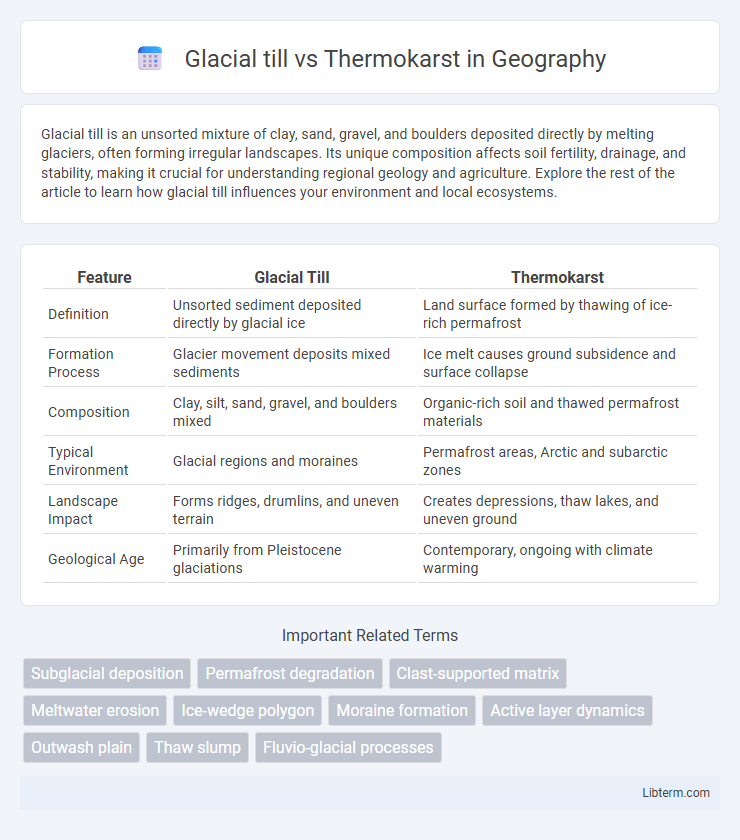Glacial till is an unsorted mixture of clay, sand, gravel, and boulders deposited directly by melting glaciers, often forming irregular landscapes. Its unique composition affects soil fertility, drainage, and stability, making it crucial for understanding regional geology and agriculture. Explore the rest of the article to learn how glacial till influences your environment and local ecosystems.
Table of Comparison
| Feature | Glacial Till | Thermokarst |
|---|---|---|
| Definition | Unsorted sediment deposited directly by glacial ice | Land surface formed by thawing of ice-rich permafrost |
| Formation Process | Glacier movement deposits mixed sediments | Ice melt causes ground subsidence and surface collapse |
| Composition | Clay, silt, sand, gravel, and boulders mixed | Organic-rich soil and thawed permafrost materials |
| Typical Environment | Glacial regions and moraines | Permafrost areas, Arctic and subarctic zones |
| Landscape Impact | Forms ridges, drumlins, and uneven terrain | Creates depressions, thaw lakes, and uneven ground |
| Geological Age | Primarily from Pleistocene glaciations | Contemporary, ongoing with climate warming |
Introduction to Glacial Till and Thermokarst
Glacial till is unsorted debris ranging from clay to boulders deposited directly by melting glaciers, shaping landscapes with features like moraines and drumlins. Thermokarst forms due to the thawing of ice-rich permafrost, resulting in irregular landforms such as depressions, pits, and sinkholes caused by ground subsidence. Both processes significantly influence soil composition, hydrology, and geomorphology in cold-region environments.
Formation Processes of Glacial Till
Glacial till forms through the direct deposition of unsorted sediments by melting glaciers, involving a mixture of clay, sand, gravel, and boulders transported and released as the ice melts. This process contrasts with thermokarst formation, which results from the thawing of ice-rich permafrost causing ground subsidence and collapse rather than sediment deposition. The unique depositional characteristics of glacial till reflect glacier movement and melting dynamics, key factors distinguishing it from the erosional and thermally-driven processes of thermokarst development.
Origins and Development of Thermokarst
Thermokarst forms from the thawing of ice-rich permafrost, leading to ground subsidence and irregular landforms such as sinkholes and ponds, contrasting with glacial till, which consists of unsorted sediments deposited directly by glacial ice. The development of thermokarst is driven by climate warming, causing permafrost degradation and enhanced surface water accumulation. This process results in dynamic landscape changes distinct from the static deposition of glacial till during glacial retreat.
Physical Characteristics: Glacial Till vs Thermokarst
Glacial till consists of unsorted, heterogeneous sediments ranging from clay to boulders, deposited directly by glacier ice, resulting in dense, compacted ground with variable grain sizes and poor layering. Thermokarst features irregular surfaces formed by the thawing of ice-rich permafrost, leading to subsidence, depressions, and uneven terrain characterized by thawed soil and meltwater accumulation. While glacial till presents a more consolidated physical structure, thermokarst landscapes exhibit dynamic, unstable ground with distinct thermal erosion and sediment displacement patterns.
Geographic Distribution and Occurrence
Glacial till primarily occurs in regions previously covered by continental glaciers, such as large parts of North America, Northern Europe, and Siberia, where it forms unsorted sediments deposited directly by glacial ice. Thermokarst landscapes are prevalent in permafrost areas across the Arctic and subarctic regions, including Alaska, Canada, and northern Russia, developing through the thawing of ice-rich permafrost that causes ground subsidence and pond formation. The geographic distribution of glacial till is linked to former glacial activity, whereas thermokarst occurrence depends on permafrost thaw dynamics and climatic warming trends.
Environmental Impacts of Glacial Till
Glacial till, an unsorted sediment deposited directly by glacial ice, significantly impacts soil composition and local hydrology by creating heterogeneous layers that affect water infiltration and retention. This sediment influences vegetation patterns and nutrient cycling, often leading to unique ecosystems adapted to these specific conditions, while also contributing to landscape stability and erosion control. In contrast, thermokarst landscapes result from thawing permafrost and cause ground subsidence, leading to increased greenhouse gas emissions and altered drainage networks.
Ecological Consequences of Thermokarst
Thermokarst landscapes form when permafrost thaws, causing ground subsidence and altered hydrology that significantly impacts local ecosystems. This thaw-induced terrain destabilization often leads to increased greenhouse gas emissions like methane and carbon dioxide, accelerating climate change. In contrast, glacial till, composed of unsorted sediments deposited by glaciers, creates more stable soils that support distinct vegetation and habitats without the dynamic ecological disruptions seen in thermokarst areas.
Key Differences Between Glacial Till and Thermokarst
Glacial till consists of unsorted glacial debris deposited directly by ice, characterized by a mixture of clay, sand, gravel, and boulders, while thermokarst refers to landforms resulting from the thawing of ice-rich permafrost, leading to subsidence and irregular surface features like pits and depressions. Glacial till represents a depositional environment shaped by glacier movement, whereas thermokarst is a geomorphological process caused by permafrost degradation triggered by climate change. These distinctions highlight differences in origin, composition, and landform morphology between glacial till and thermokarst landscapes.
Climate Change Effects on Glacial Till and Thermokarst
Climate change accelerates the melting of glaciers, causing increased sediment deposition in glacial till, which alters soil structure and hydrology. Rising temperatures also intensify thermokarst processes by thawing permafrost, leading to ground subsidence and the release of stored greenhouse gases like methane and carbon dioxide. These changes contribute to landscape instability and exacerbate carbon feedback loops, impacting global climate systems.
Summary: Understanding Glacial Till vs Thermokarst
Glacial till is an unsorted sediment deposited directly by glaciers, composed of clay, sand, gravel, and boulders, indicating past glacial activity. Thermokarst forms from the thawing of ice-rich permafrost, causing ground subsidence and irregular land surfaces characterized by ponds, sinkholes, and hummocks. Understanding the differences between glacial till and thermokarst is crucial for interpreting landscape evolution in cold regions and assessing permafrost-related environmental changes.
Glacial till Infographic

 libterm.com
libterm.com